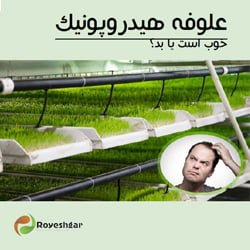
Get To Know The Hydroponic Fodder

According to importance of saving water consumption in animal husbandry and agriculture , we have decided to introduce new fodder systems in the world.
One of the most discussed issues in the forage industry in the world is the production of hydroponic fodder. In this case,farmers buy hydroponic fodder growth chamber to produce significant amounts of fodder in a small space.
Hydroponic fodder production involves the growth of grain seeds by provided moisture and nutrients outside of known growth medium such as soil or Cocopit….
The seed reacts to receiving moisture and nutrients and starts to germinate,Which results in a 5 to 8-day forage production with 200 to 250 mm height and mixed roots and The result is the harvesting green fodders and opened seeds of grains and grown roots
As there is no soil dependence on the method of producing this fodder Instead of using the word ‘Hydroponic Fodder’, the term hydrofoil can be used and also due to not having dependence to soil , hydroponic fodder is prevented from most of pests and blights
Seeds that grows well in this system
And its hydroponic fodder is good , proper and edible for livestock are : wheat, barley, corn, etc.
اHydroponic Fodder Growth Chamber have been able to produce the maximum amount of forage from seeds by germination. that is about 6 to 8 KG per 1 KG of seed.


Goals of producing hydroponic fodder
Benefits of Smart fodder growth chamber
Achieving Sustainable Development
Seed yield to forage

Goals that hydroponic fodder production follows
2) Creating employment and generating the right income for the community.
3) Protecting rangelands by preventing and reducing grazing pressure.
4) Prevent slaughter of cattle before optimal weight and optimal use of available resources
5) Providing a portion of the community's need to animal protein in order to achieving the independence in animal nutrition.

Benefits of Royeshgar's Smart fodder growth chamber
2) Producing fresh forage with high protein, vitamin and oxygen.
3) Positive effects on the genital and digestive system.
4) Increased fertility, lambing and multiple birth.
5) No worries about providing livestock in all seasons and conditions.
6) No dependence on environmental and atmospheric conditions.
7)Ability to raise livestock of any size and type.

Achieving Sustainable Development
2) Survival of valuable medicinal plants.
3) Reduction in using additives.
4) Reduction of drug use in livestock
5) Non-destruction of rangelands.
6) Using of animal nutrients excretas for restoration pastures and farms.

Results and Benefits of Hydroponic Fodder Production Plan
2) Drastic reduction of energy consumption
3) No seed waste
4) Free forage insurance
5) Optimized land use ( Reduction of more than 90%)
6) Non-destruction of rangelands
7) Optimal consumption of fund
8) Saving time ( Reduction of more than 80%)
9) Increasing the quality and quantity of forage
10) Optimal use of human resources
11) Increasing the efficiency of livestock products( Increase up to 20%)
12) Providing fresh, organic, cheap and high quality forage for all kinds of livestock
It is recommended to watch movies on how to feed cattles

Efficiency of gaining fodder from seed
Seed yield to forage in this system is 1 to 7 which means for each kg of medium sized seed (barley),7 kg of barley hydroponic fodder(fresh fodder,pasturage,rogue) is obtained, which is fully fed to the livestock and has no loss whatsoever in terms of seed or forage.
Water of this fodder is also widely used for human nutrition to alleviate gastrointestinal problems and increase vitality and health due to the presence of potent antioxidants (chlorophyll). An obvious example of this is the use of forage juice in the daily diet of Google Inc.
In addition to being cheap and affordable, it is rich in protein, energy and vitamins because of being fresh, clean and organic alleviate some livestock problems (such as colic in horses) and increases production according to scientific articles. In this context (Eg 3.5 kg increase in milk per day in cows during lactation) (increase in milk intake up to 1 kg per day) Learn to pronounce It has also been shown to increase weight gain from 330 to 450 grams per day in sheep.

Get to Know Hydroponic Cultivation
Hydroponics is a Greek word for "Hydro" meaning water and "ponos" meaning work. Literally it means working with water. Hydroponics is the science of non-soil products. Vertical hydroponic cultivation system is, in fact, a substrate method for hydroponic cultivation that increases the yield of a fixed area under cultivation by increasing plant density.
Using this method of cultivation and considering its initial cost, which is equivalent to other conventional methods of planting, can increase productivity of the crop in the desired greenhouse or land by up to 5%.
This method has already been successfully implemented in other countries and is very suitable for cultivating all kinds of fruits and vegetables and even small flowers and can be used in almost any greenhouses with slight modifications in the way of system implementing .
This method can also be used in low-water areas of the country because of the significant reduction in water consumption. It also has the capability of adapting to acoponic and hydroponic systems.
In fact, hydroponics is the science of planting plants without soil. Roots grow in the air, which must be kept very moist, or in water that needs to be well ventilated, or in some solids other than soil that retain moisture. The water around the roots that supplies the plant with the nutrients and oxygen it needs contains balanced nutrients.
Three main proper methods hydroponic cultivation
1. Cultivation in Granular Materials.2.Cultivation in hydroponic growth medium
3. Cultivation in water
Nutritional needs of the plant root can be estimated by precisely calculating the amount of nutrient solution in the root zone and providing the chemical equilibrium of the solution. Hydroponic plant cultivation up to Dr. Greik has only been in the field of laboratory research, or occasionally in some ancient civilizations, without a proper understanding of it.Dr Greick believed in his understanding of the commercialization capability in scope of hydroponics and his observations on the techniques used in the laboratory and intended to continue these experiments with the aim of developing a business.
At the moment more than a million families in America has growth Hydroponic devices that are used for domestic consumption. France, Canada, South Africa, the Netherlands, Japan, Australia, and Germany are among the leading countries in hydroponic cultivation.
Benefits of Hydroponic Cultivation
1- Hydroponic cultivation can be used everywhere. Hydroponic crops can also be grown in areas with inadequate or contaminated soils.2- Density per unit area of hydroponic cultivation is high. In hydroponic cultivation, some crops can be grown in a small area for a short time. It is also possible to cultivate crops on multiple levels or floors.Since shipping products to the market increases the final cost, it is possible to set up a hydroponics system even in the center .of the city to reduce distance and reduce shipping costs.Regardless of the value of the land, hydroponic farms have added value
3- The volume of heavy agricultural activities is reduced. In hydroponic cultivation, there are no such activities as soil tillage, crop cultivation, seed disinfection and irrigation and other conventional activities in traditional cultivation.
4- Water consumption is drastically reduced. In a proper hydroponics system, the water consumption is significantly reduced in compared to traditional soil cultivation.
5- Problems with pests and diseases are reduced. In hydroponic cultivation, the need for disinfection is reduced and soil diseases can be easily eradicated. It is also possible in traditional cropping systems that diseases can spread from animal waste or soil microorganisms to plants and cause them to become ill, although this is rare in developed countries.
6- The weed problem is eradicated. Due to the fact that the mediums are pure and can be disinfected before the cultivation, weed seeds are unlikely to exist.
7- The production rate of the crop increases. Production in hydroponic cultivation is high and it is economically justified even in use of expensive land.
8- comsumption of food is optimized. by creating recycling systems, hydroponic nutrient solutions that have been used and still available in irrigation system, can be used again. because of this reason, it minimizes the possibility of soil and groundwater contamination.
9- the environmental conditions are in your control. Due to the fact that hydroponics systems have factors such as light, heat, humidity and greenhouse gas composition and even solubilization within a timing schedule, environmental conditions can be controlled quickly.
10- Chemical control of root zone is easy. Toxicities caused by the presence of mineral salts in the nutrient solution can be removed by proper drainage from the root zone. The pH and EC values can also be adjusted. In addition, in the hydroponic system, problems with the accumulation of mineral salts in the root zone that occur in soil crops can be avoided, especially if a good quality nutrient solution be used.
۱۱-It is easier to plant new crops. The damage caused by the displacement of plants in the hydroponic system is reduced.



